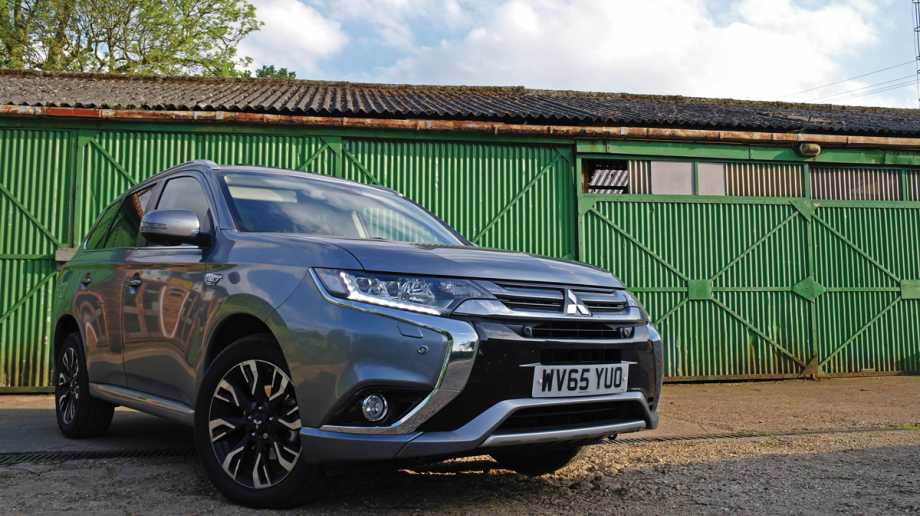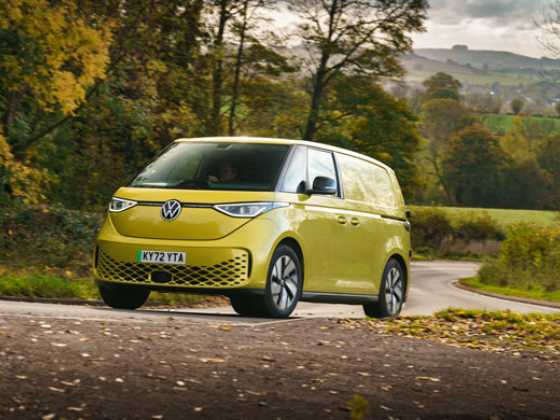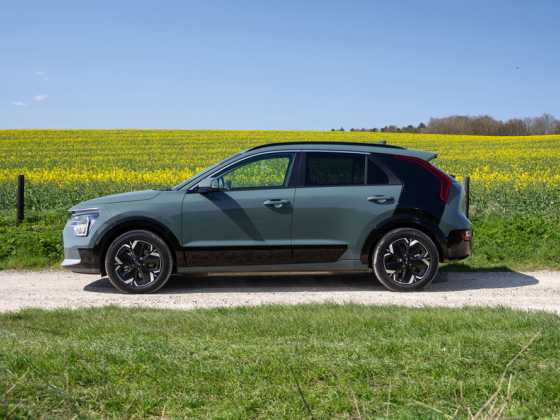PHEV Diary: Month six - Mitsubishi Outlander PHEV

GreenFleet’s sixth month with the Mitsubishi Outlander PHEV sees it once again beat all previous monthly mileage totals, and as it reaches its penultimate report, other owners share their experiences with the big plug-in hybrid SUV.
I thought WV65 YUO’s mileage bar had been well and truly reached last month, but once again, this period has seen it rise still further. Almost 2,000 miles have passed under the big Mitsubishi’s 18-inch alloy wheels since the last report. The advent of the warmer temperatures and weather has seen the all-electric range edge closer to the quoted 32 miles, though, although if the car is left standing for a while, the energy (and therefore range) drains away a little. However, as in report five (GreenFleet issue 95), there have been a couple of occasions where I have arrived home using no fuel at all, the car running under electric mode for the whole of my 25-ish mile journey. On the flip side, once again a disproportionate amount of longer journeys saw the 2.0-litre petrol engine used more than it probably should be, with the resulting fuel costs of £113.08 disappointingly higher than I’d anticipated.
With nothing major to report this month – bar the mileage reaching the 10,000 milestone – I thought I’d canvass the thoughts of owners of the Outlander PHEV to see just how it stacks up for people out in the real world. The popular and useful Speak EV forum (speakev.com) provides a good place for EV and PHEV drivers to discuss their cars, and it was largely here I gathered responses to a few key questions. Thanks to all the Mitsubishi Outlander PHEV owners who took the time to reply.
“First toe in the water of EV ownership”
It would seem that the Outlander PHEV is a vehicle which replaces one or even maybe two cars for some drivers. For others, it was a simple case of a low-tax, company car which held much appeal. Space and ‘eco‑friendliness’ played a part for many, too, and the Mitsubishi also lets drivers dip their toe in EV waters, as ‘BeeJay’ of Marlow explained: “I replaced a Range Rover and a Peugeot 107 with one car that had nearly the utility of the Range Rover, with the economy of the 107, and allowed me to put my first toe in the water of EV ownership.”
Shaun Hampton-Matthews commented that his Outlander PHEV chose itself: “As a company car driver, I was set to order another VW Tiguan until a PHEV-owning colleague pointed out the tax benefits. I did test drive the car and was pleasantly surprised at the quality and feel. A car benefit tax reduction of over £250 per month sealed the deal.”
Over the course of its past five-and-a-half months with GreenFleet, ‘our’ Outlander PHEV GX4hs has largely been used for commutes of between 25-30 miles, which usually sees the EV-range expire before the journey’s end. However, others use it on a much more local basis. Lynda Gauld for example uses her car mainly around urban environments: “I have driven around 6,400 miles in nine months and 90 per cent of those have been urban/suburban, in EV mode. Myself and my partner both work from home, so daily commutes are short – less than five miles – and usually total around 10-15 per day.”
It seems that EV-only mode is a common thing with Outlander PHEV owners. Larry Goff commented: “I actually got a warning telling me to use some petrol. I use the car for journeys to the office and only run on electricity. I’d run it so long without making the engine cut in, that the car actually told me to use some fuel as the quality of it might be degrading.” Other drivers, such as ‘lthomasrx’ commute a distance similar to mine on faster roads, stretches of urban areas either end.
Selected owners can charge the car at their place of work, too, which undoubtedly helps the economy. ‘BeeJay’ again: “I commute to my office which is 24 miles away, where I can plug in and on most days make it without the engine starting up. I also take the car on longer trips to Devon (220 miles each way), and once a week drive into central London, when I get a charge if I can.” Peter Galbavy uses his Outlander PHEV almost exclusively around the capital: “The vast majority of my journeys are round trips from home in North London into town, all within the charge range. Commuting is feasible because of the London Congestion Charge discount and unused parking spaces at work as no-one else drives in,” he said.
Destination charging, workplace charge points
Conveniently, that brings us on to charging. Most of the informal GreenFleet-canvassed Outlander owners charge up at home in the evening or overnight. Only a couple of owners said that they use the public network – and only then very occasionally – contrary to Ecotricity’s claims that its new £6 for 30 minutes charging model was brought in because Mitsubishi Outlander PHEVs are “clogging up the rapid charger network” (read more: bit.ly/2adbc6s). Others use destination charging if available, or refill the battery with workplace charge points.
The majority of our informal owner sample charge every day if they can. Shaun Hampton‑Matthews’ car is charged almost all the time: “I plug the car in when returning home, so it often charges during the day. I only use the supplied charger plugged into an outdoor 13A domestic socket.”
Some owners, such as ‘SolarBoy’ of Waterlooville are enterprising with their charges: “I have a 6kW East/West Solar panel and a dedicated 32A EV charger. When the sun is out during late spring/summer I can charge at the Outlander’s full 16 amps just using solar power and still run my home office. Even in winter enough energy is created during the month to cover the electricity used to charge.”
Lifetime economy
While a combined cycle 156mpg might be an impressive fuel economy return, we’ve all learned over the past few months that quoted figures are an inexact (and unrealistic) science. I have beaten Mitsubishi’s figure twice through judicious charging, but what do other drivers achieve? Compared to her old SAAB, Lynda Gauld saves around £138 per month and gets a regular 150mpg: “We have averaged around £28 per month in charging costs, and we are on the fifth tank of petrol. We average around 45mpg on motorway and A-road trips.” ‘SolarBoy’ stated: “Lifetime economy is just above 87mpg. On a typical day we’d not use any petrol. I use pre-heating whilst plugged in to pre-heat the vehicle during the winter, and this is absolute genius.”
For others, like ‘lthomasrx’, the Outlander’s economy is an easy thing to assess: “I purchased the car in May 2015 and my overall average since purchase is 62.09mpg. What is more convincing for me that I made the right choice is the fuel cost per mile – my 2.0-litre diesel Nissan Xtrail over three years averaged 17p per mile, the Outlander PHEV averages 10p per mile.” Ray Hanks from Manchester measured his economy over a set three-and-a-half-week period: “We achieved a staggering 229mpg. But, in truth, such measurements are academic. With our driving patterns, we ran the car for six weeks without the fuel gauge moving at all. We could call that 1,000mpg but when in full EV mode there is no significant fuel consumption, so the measurement becomes irrelevant.” ‘Wobblydeb’ meanwhile states that, “Lifetime economy is 70mpg over 3,500 miles. We do not have home charging, but are managing to do about 50 per cent of our miles on electric only.”
Jim Wardrope is another owner who rarely feels the petrol engine kick in: “For short trips, the mpg is almost infinite as the charge gets us most of our usual destinations. On a 125-mile journey between Sheffield to Cumbria, the fuel consumption is 40mpg, but that is starting with a full battery charge.” Shaun Hampton-Matthews reports that the car’s infotainment system economy read-outs are accurate: “It shows my petrol fuel economy as 33mpg. I have been keeping a note of the fuel I’ve used and the combined cycle figure is nearer 40. Both figures tally with the car’s system.”
Generally, our selected owners report economy as low as 29mpg, and as high as 150mpg, with usage cycles being critical to the results. The average in this small group seems to hover around the 60-70mpg mark.
Collective praise
Finally, I wanted to know what the owners generally think of the car. They were almost all collectively in praise of the Outlander PHEV. ‘BeeJay’ liked almost everything: “It’s faultlessly reliable, reasonably comfortable, relatively quiet (even on motorways), and the adaptive radar cruise control is awesome.”
‘SolarBoy’ is equally generous with his praise: “I love to drive this car. The steering is responsive, and it is easy and relaxing to drive. I feel safe, protected, and the LED headlights are amazing. If you need to put your foot down, mid-range acceleration is phenomenal. Grip is amazing, too, even in the wet.” He goes on: “I am a petrol head and my first car was a Ford Capri 2.0 S. I loved my Capri but think I love the Outlander PHEV more. I drive everyone bonkers by continually talking about electric cars!” I can see where he’s coming from...
Elsewhere, the on-board and motive tech appeals to ‘Wobblydeb’: “We absolutely love the technology, and believe that electric is definitely the way forward. The Outlander PHEV is lovely to drive and surprisingly easy to manoeuvre in town thanks to the parking cameras and good turning circle.”
Dislikes? The fiddly and awkward-to‑use MMCS infotainment system comes in for some criticism from our non-scientific selection of drivers (and is something we’ve talked about before: bit.ly/2adRhXQ). The only other gripe is that the car maybe doesn’t feel as well built as other 4x4s, with easily scratched paint being a notable issue. Having said that, though, owners have replaced such cars as Jaguars, Land Rovers, Mercedes, Volvos, and even Porsches with Outlander PHEVs and seem happy, especially when other factors such as the drive and the lower running costs are taken into consideration.
“Comfortable and well-built”
Porsche driver Larry Goff in particular has been impressed with his 2014 model: “It’s comfortable and well-built. I’ve come from cars such as Mercedes and Porsches and did wonder how it would compare, but overall, I’m impressed.”
Ray Hanks is almost evangelical is his love for the big Mitsubishi: “I thought I’d miss the 3.0-litre Jaguar I gave up to get the PHEV but that’s a distant memory. Right now, we plan to replace the PHEV with another at the end of the lease. In a world full of disappointment and lack of quality, EV driving and this excellent car seems to be bucking that trend.”
So, from our small and informal sample, it appears it’s not just GreenFleet which thinks the plug-in hybrid Mitsubishi is a great all‑rounder and an excellent ‘bridge’ to a proper, battery‑electric vehicle. We’ll leave the final word to Ray Hanks: “This has got to be the way of the future and the Outlander PHEV has to be a prime example of the great choices on offer. Networks of charging points will start to be better organised with a more cohesive way of using them. The big winner is clearly going to be the ozone and our health.”
Click here to read a selection of our Mitsubishi Outlander PHEV owners’ comments in full.









